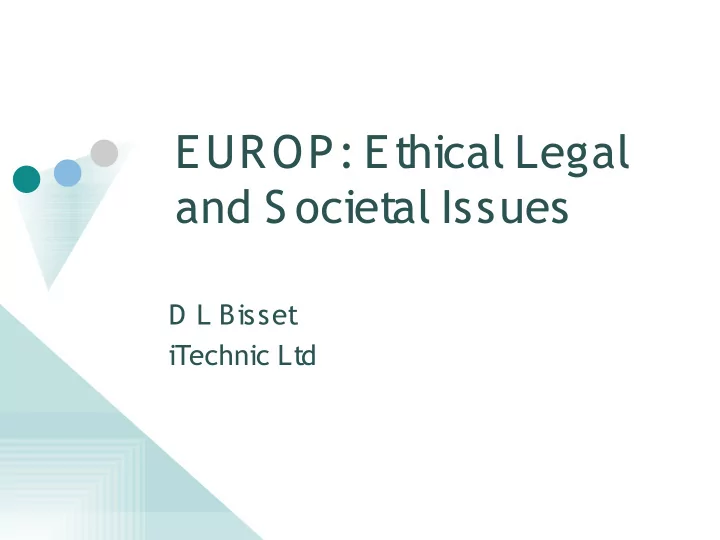

EUROP: Ethical Legal and S ocietal Issues D L Bisset iTechnic Ltd
What is EUROP? European Community Industrial/ Commercial Academic Euros Euros Product Roadmaps S trategic Research EURON EUROP Agenda FP7 Research Technology Roadmap Roadmaps Common Vision
What Does EUROP do? Provides a forum for inter-organisation exchange across Europe Industry, S ME, Consultants Government Dpts Academics User groups S timulate debate and raise awareness. Technical Commercial Ethical, Legal and S ocietal (ELS ) Educational Maintains technical roadmaps from a commercial perspective. S ets the European strategic research agenda. (FP7) Assess international activity. Aids the standardisation process.
(What? ) ELS Objectives Assess issues surrounding the introduction of Advanced Robots Legal S ocietal Ethical Particularly issues concerning direct interaction in everyday environments. Assess broader impact of Advanced Robotics on Education S ociety Explore the context of a developing robot based economy Public understanding Higher educational needs
ELS : Commercial Perspective EUROP works within a commercial context. Commercial relevance Within the technical framework of the next 10-20 years. FP6/ 7 Help the suppliers of robots and robot services understand ELS issues. Assess the impact of ELS issues on design.
(Why? ) Barriers to Market ELS issues may present significant barriers in certain markets. Medical Consent Trust Healthcare Privacy S ecurity Military S olutions to ELS issues need to be established if these markets are to flourish. Ethical framework S elf-regulation Design approval Regulation Regulatory Control Legal structure Design guides Legal Obligation
(How? ) Assessment Process Assess ELS issues in each market area. Identify key issues and barriers. Create a dialogue with non-technical experts: Lawyers Healthcare professionals Trade Unions Politicians Identify educational needs. Identify design methods.
ELS Issues ELS issues occur at the interface between User, supplier and robot. Concern, for an application, is increased by User vulnerability. A lack of user volition. By embedding robots into our everyday environments we also embed them into our legal, social and ethical infrastructures.
Application areas Increasing Interaction Manufacturing Retail Domestic Space Increasing ELS Risk Food Transport Defence Sport & Rehabilitation Security Health Care Medical
Open issues Many questions arise: How will we ensure/ reassure that robots are safe? How will we enforce “ ethical” use? How will we assign liability? How will we assess design fitness? How will we assess deployment? How will we maintain operational standards? How does this work in automobile industry? Will ethical regulation of designers be enough?
Actors Operator User Carer S upply Employer Manufacturer Guard Component S upplier Installer S oftware S upplier S ubject S ervices User Robot Maintainer Patient S ervice Provider S pectator Employee Regulators Certification Licensing Government S tandards
Legal Entity The immediate debate is not about robots needing rights it is about us needing rights and protection. It is about assigning liability and responsibility for actions and failures. Ensuring ethical use. Ensuring basic human rights are maintained. • At work • At home • In care Will this need special legislation? How can ethics be designed in?
Ethics by Design Engineering requirements impact ELS Recognition reliability Dependable operation Intrinsic safety S ystems level design impact ELS : Unethical to record video or sound for storage. Unethical to use data gained for another purpose. Deployment impacts ELS : Unethical to replace a human worker with a robot they have trained. • Reduced wage? • Poorer conditions? Unethical to only provide robot based care.
Vulnerable Elderly Care Do older people want to be cared for by a robot? How much choice will they have? The greying population may force the issue. How will we ethically assess the cost benefit? How will we assess liability when an accident occurs? What technology needs to be built in? How will we approve the system and its delivery? How will we deal with the ethics of interaction? How will we deal with adaptive care?
EUROP Next Meeting Paris 23-24 th May Need support and contributions to the ELS work. S timulate awareness of ELS issues amongst EUROP members. Need to identify non-technical domain specialists.
Recommend
More recommend